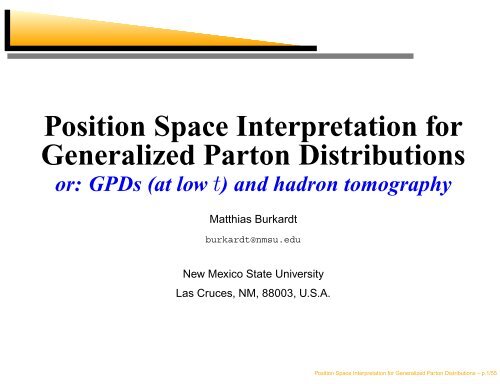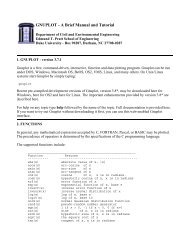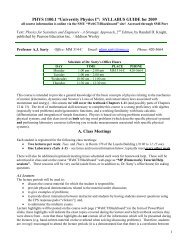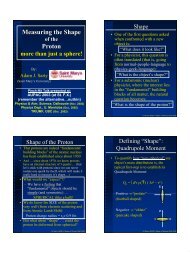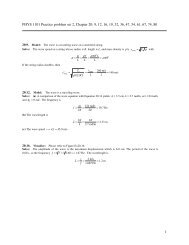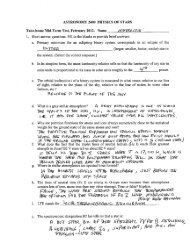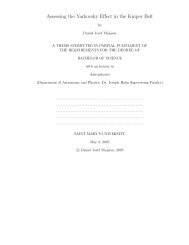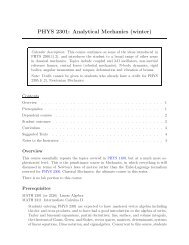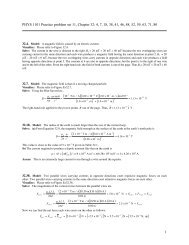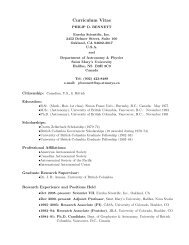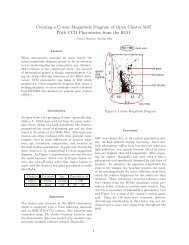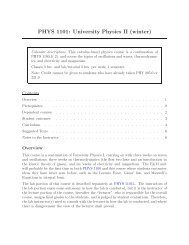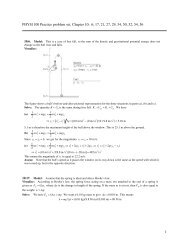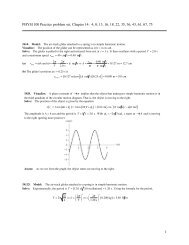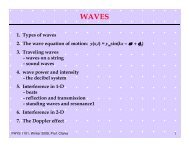Position Space Interpretation for Generalized Parton Distributions
Position Space Interpretation for Generalized Parton Distributions
Position Space Interpretation for Generalized Parton Distributions
Create successful ePaper yourself
Turn your PDF publications into a flip-book with our unique Google optimized e-Paper software.
<strong>Position</strong> <strong>Space</strong> <strong>Interpretation</strong> <strong>for</strong><br />
<strong>Generalized</strong> <strong>Parton</strong> <strong>Distributions</strong><br />
or: GPDs (at low t) and hadron tomography<br />
Matthias Burkardt<br />
burkardt@nmsu.edu<br />
New Mexico State University<br />
Las Cruces, NM, 88003, U.S.A.<br />
<strong>Position</strong> <strong>Space</strong> <strong>Interpretation</strong> <strong>for</strong> <strong>Generalized</strong> <strong>Parton</strong> <strong>Distributions</strong> – p.1/55
(brief) Motivation<br />
DIS opt.theorem<br />
−→<br />
q(x Bj ) =<br />
<strong>for</strong>ward Compton amplitude Bj−limit<br />
−→ q(x Bj )<br />
∫ ( ) ( )<br />
dx<br />
−<br />
2π 〈p|q − x− x<br />
2 ,0 ⊥ γ + −<br />
q<br />
2 ,0 ⊥ |p〉 e ix− x Bj P +<br />
Light-cone coordinates x ± = 1 √<br />
2<br />
(<br />
x 0 ± x 1)<br />
q(x) = light-cone momentum distribution of quarks in the<br />
target; x = (light-cone) momentum fraction<br />
no in<strong>for</strong>mation about position of partons!<br />
<strong>Position</strong> <strong>Space</strong> <strong>Interpretation</strong> <strong>for</strong> <strong>Generalized</strong> <strong>Parton</strong> <strong>Distributions</strong> – p.2/55
(brief) Motivation<br />
generalization to p ′ ≠ p ⇒ <strong>Generalized</strong> <strong>Parton</strong> <strong>Distributions</strong><br />
GPD(x, ξ, t) ≡<br />
∫ dx<br />
−<br />
2π 〈p′ |q<br />
( ) ( )<br />
− x− x<br />
2 ,0 ⊥ γ + −<br />
q<br />
2 ,0 ⊥ |p〉 e ix− xP +<br />
with ∆ = p − p ′ , t = ∆ 2 , and ξ(p + + p +′ ) = −2∆ + .<br />
can be probed e.g. in Deeply Virtual Compton Scattering<br />
(DVCS) (HERMES, JLab@12GeV, eRHIC, ...)<br />
Interesting observation: X.Ji, PRL78,610(1997)<br />
〈J q 〉 = 1 2<br />
∫ 1<br />
0<br />
dxx[H q (x, 0, 0) + E q (x, 0, 0)]<br />
DVCS ⇔ GPDs ⇔ ⃗J q<br />
But: what other “physical in<strong>for</strong>mation” about the nucleon can<br />
we obtain by measuring/calculating GPDs<br />
<strong>Position</strong> <strong>Space</strong> <strong>Interpretation</strong> <strong>for</strong> <strong>Generalized</strong> <strong>Parton</strong> <strong>Distributions</strong> – p.3/55
Outline<br />
Probabilistic interpretation of GPDs as Fourier trans<strong>for</strong>ms of<br />
impact parameter dependent PDFs<br />
H(x, 0, −∆ 2 ⊥ ) FT<br />
−→ q(x,b ⊥ )<br />
˜H(x, 0, −∆ 2 ⊥ ) FT<br />
−→ ∆q(x,b ⊥ )<br />
E(x, 0, −∆ 2 ⊥ ) −→ ⊥ distortion of PDFs when the<br />
target is transversely polarized<br />
<strong>Position</strong> <strong>Space</strong> <strong>Interpretation</strong> <strong>for</strong> <strong>Generalized</strong> <strong>Parton</strong> <strong>Distributions</strong> – p.4/55
<strong>Generalized</strong> <strong>Parton</strong> <strong>Distributions</strong> (GPDs)<br />
∫ dx<br />
−<br />
2π eix−¯p + x<br />
〈 ∣ (<br />
p<br />
∣∣∣¯q<br />
′ − x− 2<br />
)<br />
γ + q<br />
( )∣ x<br />
− ∣∣∣<br />
p〉<br />
2<br />
= H(x, ξ, ∆ 2 )ū(p ′ )γ + u(p)<br />
+E(x, ξ, ∆ 2 )ū(p ′ ) iσ+ν ∆ ν<br />
2M<br />
u(p)<br />
∫ dx<br />
−<br />
2π eix−¯p + x<br />
〈 ∣ (<br />
p<br />
∣∣∣¯q<br />
′ − x− 2<br />
)<br />
γ + γ 5 q<br />
( )∣ x<br />
− ∣∣∣<br />
p〉<br />
2<br />
= ˜H(x, ξ, ∆ 2 )ū(p ′ )γ + γ 5 u(p)<br />
!+Ẽ(x, ξ, ∆2 )ū(p ′ ) γ 5∆ +<br />
2M u(p)<br />
where ∆ = p − p ′ is the momentum transfer and ξ measures the longitudinal<br />
momentum transfer on the target ∆ + = ξ(p + + p +′ ).<br />
<strong>Position</strong> <strong>Space</strong> <strong>Interpretation</strong> <strong>for</strong> <strong>Generalized</strong> <strong>Parton</strong> <strong>Distributions</strong> – p.5/55
<strong>Parton</strong> <strong>Interpretation</strong><br />
∫ dx<br />
−<br />
2π eix−¯p + x<br />
〈 ∣ (<br />
p<br />
∣∣∣¯q<br />
′ − x− 2<br />
)<br />
γ + q<br />
( )∣ x<br />
− ∣∣∣<br />
p〉<br />
2<br />
= H(x, ξ, ∆ 2 )ū(p ′ )γ + u(p)<br />
+E(x, ξ, ∆ 2 )ū(p ′ ) iσ+ν ∆ ν<br />
2M<br />
u(p)<br />
x = mean long. momentum fraction carried by active quark<br />
ξ = longitudinal (p + ) momentum transfer<br />
In general no probabilistic interpretation since initial and final state<br />
not the same<br />
Instead: interpretation as transition amplitude<br />
∫ ∫<br />
dxH(x, ξ, ∆ 2 ) = F 1 (∆ 2 ) and dxE(x, ξ, ∆ 2 ) = F 2 (∆ 2 )<br />
↩→ GPDs provide a decomposition of <strong>for</strong>m factor w.r.t. the momentum<br />
fraction (in IMF) carried by the active quark<br />
Actually GPD = GPD(x, ξ, ∆ 2 , q 2 ), but will not discuss q 2<br />
dependence of GPDs today! (−→ resolution in ⊥ direction)<br />
<strong>Position</strong> <strong>Space</strong> <strong>Interpretation</strong> <strong>for</strong> <strong>Generalized</strong> <strong>Parton</strong> <strong>Distributions</strong> – p.6/55
What is Physics of GPDs <br />
Definition of GPDs resembles that of <strong>for</strong>m factors<br />
〈 ∣ 〉<br />
p ′ ∣∣ Ô∣ p = H(x, ξ, ∆ 2 )ū(p ′ )γ + u(p) + E(x, ξ, ∆ 2 )ū(p ′ ) iσ+ν ∆ ν<br />
2M<br />
u(p)<br />
with Ô ≡ ∫ ( ) ( )<br />
dx −<br />
2π<br />
eix−¯p<br />
+x¯q − x− 2<br />
γ + x<br />
q<br />
− 2<br />
↩→ relation between PDFs and GPDs similar to relation between a<br />
charge and a <strong>for</strong>m factor<br />
↩→ If <strong>for</strong>m factors can be interpreted as Fourier trans<strong>for</strong>ms of charge<br />
distributions in position space, what is the analogous physical<br />
interpretation <strong>for</strong> GPDs <br />
<strong>Position</strong> <strong>Space</strong> <strong>Interpretation</strong> <strong>for</strong> <strong>Generalized</strong> <strong>Parton</strong> <strong>Distributions</strong> – p.7/55
Form Factors vs. GPDs<br />
operator<br />
<strong>for</strong>ward<br />
matrix elem.<br />
off-<strong>for</strong>ward<br />
matrix elem.<br />
position space<br />
¯qγ + q<br />
Q<br />
F(t)<br />
ρ(⃗r)<br />
∫ dx − e ixp+ x −<br />
4π<br />
(<br />
¯q<br />
−x −<br />
2<br />
)<br />
(<br />
γ + x<br />
q<br />
− 2<br />
)<br />
q(x)<br />
H(x, ξ, t)<br />
<br />
<strong>Position</strong> <strong>Space</strong> <strong>Interpretation</strong> <strong>for</strong> <strong>Generalized</strong> <strong>Parton</strong> <strong>Distributions</strong> – p.8/55
Form Factors vs. GPDs<br />
operator<br />
<strong>for</strong>ward<br />
matrix elem.<br />
off-<strong>for</strong>ward<br />
matrix elem.<br />
position space<br />
¯qγ + q<br />
Q<br />
F(t)<br />
ρ(⃗r)<br />
∫ dx − e ixp+ x −<br />
4π<br />
(<br />
¯q<br />
−x −<br />
2<br />
)<br />
(<br />
γ + x<br />
q<br />
− 2<br />
)<br />
q(x)<br />
H(x, 0, t)<br />
q(x,b ⊥ )<br />
q(x,b ⊥ ) = impact parameter dependent PDF<br />
<strong>Position</strong> <strong>Space</strong> <strong>Interpretation</strong> <strong>for</strong> <strong>Generalized</strong> <strong>Parton</strong> <strong>Distributions</strong> – p.9/55
Impact parameter dependent PDFs<br />
define state that is localized in ⊥ position:<br />
∣<br />
∣p + ,R ⊥ = 0 ⊥ , λ 〉 ≡ N<br />
∫<br />
d 2 p ⊥<br />
∣ ∣ p + ,p ⊥ , λ 〉<br />
Note: ⊥ boosts in IMF <strong>for</strong>m Galilean subgroup ⇒ this state has<br />
∫<br />
R ⊥ ≡ 1<br />
P dx − d 2 x + ⊥ x ⊥ T ++ (x) = 0 ⊥<br />
(cf.: working in CM frame in nonrel. physics)<br />
define impact parameter dependent PDF<br />
∫ dx<br />
−〈 ∣<br />
q(x,b ⊥ ) ≡ p + ,0 ⊥ ¯q<br />
4π<br />
) ( ) (− x− x<br />
2 ,b ⊥ γ + − ∣∣<br />
q<br />
2 ,b 〉<br />
⊥ p + ,0 ⊥ e<br />
ixp + x −<br />
<strong>Position</strong> <strong>Space</strong> <strong>Interpretation</strong> <strong>for</strong> <strong>Generalized</strong> <strong>Parton</strong> <strong>Distributions</strong> – p.10/55
Impact parameter dependent PDFs<br />
q(x,b ⊥ ) ≡<br />
use translational invariance to relate to same matrix element that<br />
appears in def. of GPDs<br />
∫<br />
dx −〈 p + ,R ⊥ = 0 ⊥<br />
∣ ∣¯q(− x−<br />
2 ,b ⊥)γ + q( x−<br />
2 ,b ⊥) ∣ ∣p + ,R ⊥ = 0 ⊥<br />
〉<br />
e<br />
ixp + x −<br />
∫ ∫<br />
= |N | 2 d 2 p ⊥<br />
∫d 2 p ′ ⊥<br />
dx −〈 ∣<br />
p + ,p ′ ⊥<br />
∣¯q(− x−<br />
2 ,b ⊥)γ + q( x−<br />
2 ,b ⊥) ∣ 〉<br />
∣p + ,p ⊥ e<br />
ixp + x −<br />
<strong>Position</strong> <strong>Space</strong> <strong>Interpretation</strong> <strong>for</strong> <strong>Generalized</strong> <strong>Parton</strong> <strong>Distributions</strong> – p.11/55
Impact parameter dependent PDFs<br />
q(x,b ⊥ ) ≡<br />
use translational invariance to relate to same matrix element that<br />
appears in def. of GPDs<br />
∫<br />
dx − 〈 p + ,R ⊥ = 0 ⊥<br />
∣ ∣ ¯q(− x−<br />
2 ,b ⊥)γ + q( x−<br />
2 ,b ⊥) ∣ ∣p + ,R ⊥ = 0 ⊥<br />
〉<br />
e<br />
ixp + x −<br />
∫ ∫<br />
= |N | 2 d 2 p ⊥<br />
∫d 2 p ′ ⊥<br />
∫ ∫<br />
= |N | 2 d 2 p ⊥<br />
∫d 2 p ′ ⊥<br />
dx −〈 p + ,p ′ ∣<br />
⊥ ¯q(− x−<br />
2 ,b ⊥)γ + q( x−<br />
2 ,b ⊥) ∣ 〉<br />
∣p + ,p ⊥ e<br />
ixp + x −<br />
dx −〈 p + ,p ′ ∣<br />
⊥ ¯q(− x−<br />
2 ,0 ⊥)γ + q( x−<br />
2 ,0 ⊥) ∣ ∣p + 〉<br />
,p ⊥ e<br />
ixp + x −<br />
×e ib ⊥·(p ⊥ −p ′ ⊥ )<br />
<strong>Position</strong> <strong>Space</strong> <strong>Interpretation</strong> <strong>for</strong> <strong>Generalized</strong> <strong>Parton</strong> <strong>Distributions</strong> – p.12/55
Impact parameter dependent PDFs<br />
q(x,b ⊥ ) ≡<br />
use translational invariance to relate to same matrix element that<br />
appears in def. of GPDs<br />
∫<br />
dx − 〈 p + ,R ⊥ = 0 ⊥<br />
∣ ∣ ¯q(− x−<br />
2 ,b ⊥)γ + q( x−<br />
2 ,b ⊥) ∣ ∣p + ,R ⊥ = 0 ⊥<br />
〉<br />
e<br />
ixp + x −<br />
∫ ∫<br />
= |N | 2 d 2 p ⊥<br />
∫d 2 p ′ ⊥<br />
∫ ∫<br />
= |N | 2 d 2 p ⊥<br />
∫d 2 p ′ ⊥<br />
= |N | 2 ∫<br />
d 2 p ⊥<br />
∫d 2 p ′ ⊥H<br />
dx −〈 p + ,p ′ ∣<br />
⊥ ¯q(− x−<br />
2 ,b ⊥)γ + q( x−<br />
2 ,b ⊥) ∣ 〉<br />
∣p + ,p ⊥ e<br />
ixp + x −<br />
dx −〈 p + ,p ′ ∣<br />
⊥ ¯q(− x−<br />
2 ,0 ⊥)γ + q( x−<br />
2 ,0 ⊥) ∣ ∣p + 〉<br />
,p ⊥ e<br />
ixp + x −<br />
×e ib ⊥·(p ⊥ −p ′ ⊥ )<br />
(<br />
x, 0, − (p ′ ⊥ − p ⊥ ) 2) e ib ⊥·(p ⊥ −p ′ ⊥ )<br />
↩→ q(x,b ⊥ ) =<br />
∫ d 2 ∆ ⊥<br />
(2π) 2 H(x, 0, −∆2 ⊥)e ib ⊥·∆ ⊥<br />
<strong>Position</strong> <strong>Space</strong> <strong>Interpretation</strong> <strong>for</strong> <strong>Generalized</strong> <strong>Parton</strong> <strong>Distributions</strong> – p.13/55
Impact parameter dependent PDFs<br />
q(x,b ⊥ ) =<br />
∫ d 2 ∆ ⊥<br />
(2π) 2 H(x, 0, −∆2 ⊥)e ib ⊥·∆ ⊥<br />
(∆ ⊥ = p ⊥ − p ′ ⊥ , ξ = 0)<br />
q(x,b ⊥ ) has physical interpretation of a density<br />
q(x,b ⊥ ) ≥ 0 <strong>for</strong> x > 0<br />
q(x,b ⊥ ) ≤ 0 <strong>for</strong> x < 0<br />
<strong>Position</strong> <strong>Space</strong> <strong>Interpretation</strong> <strong>for</strong> <strong>Generalized</strong> <strong>Parton</strong> <strong>Distributions</strong> – p.14/55
Discussion: GPD ↔ q(x,b ⊥ )<br />
GPDs allow simultaneous determination of longitudinal<br />
momentum and transverse position of partons<br />
q(x,b ⊥ ) =<br />
∫ d 2 ∆ ⊥<br />
(2π) 2 H(x, 0, −∆2 ⊥)e ib ⊥·∆ ⊥<br />
very similar results <strong>for</strong> impact parameter dependent polarized<br />
quark distributions (nucleon longitudinally polarized)<br />
∆q(x,b ⊥ ) =<br />
∫ d 2 ∆ ⊥<br />
(2π) 2 ˜H(x, 0, −∆ 2 ⊥)e ib ⊥·∆ ⊥<br />
q(x,b ⊥ ) has interpretation as density (positivity constraints!)<br />
q(x,b ⊥ ) ∼ 〈 p + ,0 ⊥<br />
∣ ∣ b † (xp + ,b ⊥ )b(xp + ,b ⊥ ) ∣ ∣p + ,0 ⊥<br />
〉<br />
= ∣ ∣b(xp + ,b ⊥ )|p + ,0 ⊥<br />
〉∣ ∣<br />
2<br />
≥ 0<br />
↩→ probabilistic interpretation!<br />
<strong>Position</strong> <strong>Space</strong> <strong>Interpretation</strong> <strong>for</strong> <strong>Generalized</strong> <strong>Parton</strong> <strong>Distributions</strong> – p.15/55
Discussion: GPD ↔ q(x,b ⊥ )<br />
Nonrelativistically, connection<br />
H(x, 0, −∆ 2 ⊥) FT<br />
←→ q(x,b ⊥ )<br />
not surprising!<br />
Absence of relativistic corrections to identification<br />
H(x, 0, −∆ 2 ⊥ ) ←→ FT<br />
q(x,b ⊥ ) due to Galilean subgroup in IMF<br />
<strong>Position</strong> <strong>Space</strong> <strong>Interpretation</strong> <strong>for</strong> <strong>Generalized</strong> <strong>Parton</strong> <strong>Distributions</strong> – p.16/55
Discussion: GPD ↔ q(x,b ⊥ )<br />
b ⊥ distribution measured w.r.t. R CM<br />
⊥<br />
≡ ∑ i x ir i,⊥<br />
↩→ width of the b ⊥ distribution should go to zero as x → 1, since<br />
the active quark becomes the ⊥ center of momentum in that limit!<br />
↩→ H(x, 0, t) must become t-indep. as x → 1.<br />
Use intuition about nucleon structure in position space to make<br />
predictions <strong>for</strong> GPDs:<br />
large x (x ≫ m π<br />
M N<br />
): quarks from localized valence ‘core’,<br />
small x (x ∼ m π<br />
M N<br />
or less): contributions from larger ‘pion cloud’<br />
(C.Weiss et al.)<br />
↩→ size of hadrons in impact parameter space expected to increase<br />
as x decreases<br />
↩→ expect decrease of the t-dependence (⊥ size) in H(x, 0, t) as x<br />
increases (recently confirmed in LGT calcs. by J.W.Negele et al.)<br />
model: H q (x, 0, −∆ 2 ⊥ ) = q(x)e−a∆2 ⊥ (1−x)ln 1 x .<br />
<strong>Position</strong> <strong>Space</strong> <strong>Interpretation</strong> <strong>for</strong> <strong>Generalized</strong> <strong>Parton</strong> <strong>Distributions</strong> – p.17/55
The physics of E(x, 0, −∆ 2 ⊥ )<br />
So far: only unpolarized (or long. polarized) nucleon<br />
In general, use ( ∆ + = 0)<br />
∫ 〈<br />
( ) ( )∣ dx<br />
−<br />
x − x<br />
4π eip+ P+∆,↑ ∣ −x<br />
− x ∣¯q γ + − ∣∣∣<br />
q P,↑〉<br />
2 2<br />
∫ 〈<br />
( ) ( )∣ dx<br />
−<br />
x − x<br />
4π eip+ P+∆,↑ ∣ −x<br />
− x ∣¯q γ + − ∣∣∣<br />
q P,↓〉<br />
2 2<br />
= H(x,0,−∆ 2 ⊥)<br />
= − ∆ x−i∆ y<br />
2M<br />
E(x,0,−∆2 ⊥).<br />
Consider nucleon polarized in x direction (in IMF)<br />
|X〉 ≡ |p + ,R ⊥ = 0 ⊥ , ↑〉 + |p + ,R ⊥ = 0 ⊥ , ↓〉.<br />
↩→ unpolarized quark distribution <strong>for</strong> this state:<br />
q X (x,b ⊥ ) = q(x,b ⊥ ) − 1<br />
2M<br />
∂<br />
∂b y<br />
∫ d 2 ∆ ⊥<br />
(2π) 2 E(x, 0,−∆2 ⊥)e ib ⊥·∆ ⊥<br />
<strong>Position</strong> <strong>Space</strong> <strong>Interpretation</strong> <strong>for</strong> <strong>Generalized</strong> <strong>Parton</strong> <strong>Distributions</strong> – p.18/55
The physics of E(x, 0, −∆ 2 ⊥ )<br />
q X (x,b ⊥ ) in transversely polarized nucleon is transversely<br />
distorted compared to longitudinally polarized nucleons !<br />
mean displacement of flavor q (⊥ flavor dipole moment)<br />
d q y ≡<br />
∫<br />
∫<br />
dx<br />
d 2 b ⊥ q X (x,b ⊥ )b y = 1<br />
2M<br />
with κ p u/d ≡ F u/d<br />
2 (0) = O(1 − 2) ⇒ d q y = O(0.2fm)<br />
∫<br />
dxE q (x, 0, 0) = κp q<br />
2M<br />
CM <strong>for</strong> flavor q shifted relative to CM <strong>for</strong> whole proton by<br />
∫<br />
∫<br />
dx<br />
d 2 b ⊥ q X (x,b ⊥ )xb y = 1<br />
2M<br />
∫<br />
dxxE q (x, 0, 0)<br />
↩→ not surprising to find that second moment of E q is related to<br />
angular momentum carried by flavor q<br />
<strong>Position</strong> <strong>Space</strong> <strong>Interpretation</strong> <strong>for</strong> <strong>Generalized</strong> <strong>Parton</strong> <strong>Distributions</strong> – p.19/55
¢ £¢ ¤ ¢<br />
¡<br />
physical origin <strong>for</strong> ⊥ distortion<br />
Comparison of a non-rotating sphere that moves in z direction with a<br />
sphere that spins at the same time around the z axis and a sphere that<br />
spins around the x axis When the sphere spins around the x axis, the<br />
rotation changes the distribution of momenta in the z direction<br />
(adds/subtracts to velocity <strong>for</strong> y > 0 and y < 0 respectively). For the<br />
nucleon the resulting modification of the (unpolarized) momentum<br />
distribution is described by E(x, 0, −∆ 2 ⊥ ). <strong>Position</strong> <strong>Space</strong> <strong>Interpretation</strong> <strong>for</strong> <strong>Generalized</strong> <strong>Parton</strong> <strong>Distributions</strong> – p.20/55
simple model <strong>for</strong> E q (x, 0, −∆ 2 ⊥ )<br />
For simplicity, make ansatz where E q ∝ H q<br />
with<br />
E u (x, 0, −∆ 2 ⊥) = κp u<br />
2 H u(x, 0, −∆ 2 ⊥)<br />
E d (x, 0, −∆ 2 ⊥) = κ p d H d(x, 0, −∆ 2 ⊥)<br />
κ p u = 2κ p + κ n = 1.673<br />
κ p d = 2κ n + κ p = −2.033.<br />
Satisfies: ∫ dxE q (x, 0, 0) = κ P q<br />
Model too simple but illustrates that anticipated distortion is very<br />
significant since κ u and κ d known to be large!<br />
<strong>Position</strong> <strong>Space</strong> <strong>Interpretation</strong> <strong>for</strong> <strong>Generalized</strong> <strong>Parton</strong> <strong>Distributions</strong> – p.21/55
u(x,b ⊥ ) u X (x,b ⊥ )<br />
d(x,b ⊥ ) d X (x,b ⊥ )<br />
b y<br />
b y<br />
b y<br />
b y<br />
b x<br />
b x<br />
b x<br />
b x<br />
x = 0.1<br />
x = 0.1<br />
x = 0.1<br />
x = 0.1<br />
b y<br />
b y<br />
b y<br />
b y<br />
b x<br />
b x<br />
b x<br />
b x<br />
x = 0.3<br />
x = 0.3<br />
x = 0.3<br />
x = 0.3<br />
b y<br />
b y<br />
b y<br />
b y<br />
b x<br />
b x<br />
b x<br />
b x<br />
x = 0.5<br />
x = 0.5<br />
x = 0.5<br />
x = 0.5<br />
<strong>Position</strong> <strong>Space</strong> <strong>Interpretation</strong> <strong>for</strong> <strong>Generalized</strong> <strong>Parton</strong> <strong>Distributions</strong> – p.22/55
connection with ⊥ SSA<br />
example: γp → πX (Breit frame)<br />
⃗p γ ⃗p N d<br />
π +<br />
u, d distributions in ⊥ polarized proton have left-right asymmetry in<br />
⊥ position space (T-even!); sign determined by κ u & κ d<br />
attractive FSI deflects active quark towards the center of<br />
momentum<br />
↩→ FSI converts left-right position space asymmetry of leading quark<br />
into right-left asymmetry in momentum<br />
compare: convex lens that is illuminated asymmetrically<br />
↩→ semi-classical picture <strong>for</strong> recent results by Brodsky et al.<br />
natural explanation <strong>for</strong> correlation between sign of κ q and sign of<br />
SSA<br />
u<br />
<strong>Position</strong> <strong>Space</strong> <strong>Interpretation</strong> <strong>for</strong> <strong>Generalized</strong> <strong>Parton</strong> <strong>Distributions</strong> – p.23/55
Other topics<br />
QCD evolution<br />
extrapolating to ξ = 0<br />
transverse hyperon polarization<br />
<strong>Position</strong> <strong>Space</strong> <strong>Interpretation</strong> <strong>for</strong> <strong>Generalized</strong> <strong>Parton</strong> <strong>Distributions</strong> – p.24/55
Summary<br />
DVCS allows probing GPDS<br />
∫ 〈 ∣ (<br />
dx<br />
−<br />
x −<br />
2π eixp+ p<br />
∣∣∣¯q<br />
′ − x− 2<br />
)<br />
γ + q<br />
( )∣ x<br />
− ∣∣∣<br />
p〉<br />
2<br />
GPDs resemble both PDFs and <strong>for</strong>m factors:<br />
defined through matrix elements of light-cone correlation, but<br />
∆ ≡ p ′ − p ≠ 0.<br />
t-dependence of GPDs at ξ=0 (purely ⊥ momentum transfer) ⇒<br />
Fourier trans<strong>for</strong>m of impact parameter dependent PDFs q(x,b ⊥ )<br />
↩→ knowledge of GPDs <strong>for</strong> ξ = 0 provides novel in<strong>for</strong>mation about<br />
nonperturbative parton structure of nucleons: distribution of<br />
partons in ⊥ plane<br />
q(x,b ⊥ ) = ∫ d 2 ∆ ⊥<br />
(2π)<br />
H(x, 0, −∆ 2 2 ⊥ )eib ⊥·∆ ⊥<br />
∆q(x,b ⊥ ) = ∫ d 2 ∆ ⊥<br />
(2π) 2 ˜H(x, 0, −∆ 2 ⊥ )eib ⊥·∆ ⊥<br />
q(x,b ⊥ ), ∆q(x,b ⊥ ) have probabilistic interpretation, e.g.<br />
q(x,b ⊥ ) > 0 <strong>for</strong> x > 0<br />
<strong>Position</strong> <strong>Space</strong> <strong>Interpretation</strong> <strong>for</strong> <strong>Generalized</strong> <strong>Parton</strong> <strong>Distributions</strong> – p.25/55
Summary<br />
∆ ⊥<br />
2M E(x, 0, −∆2 ⊥<br />
) describes how the momentum distribution of<br />
unpolarized partons in the ⊥ plane gets transversely distorted<br />
when is nucleon polarized in ⊥ direction.<br />
(attractive) final state interaction converts ⊥ position space<br />
asymmetry into ⊥ momentum space asymmetry<br />
↩→ simple physical explanation <strong>for</strong> sign of Sivers asymmetry<br />
Similar mechanism also applicable to many other semi-inclusive<br />
events, such as transverse polarizations in hyperon production.<br />
published in: M.B., PRD 62, 71503 (2000), hep-ph/0105324, and<br />
hep-ph/0207047; see also D. Soper, PRD 15, 1141 (1977).<br />
Connection to SSA in M.B., PRD 66, 114005 (2002);<br />
hep-ph/0302144.<br />
<strong>Position</strong> <strong>Space</strong> <strong>Interpretation</strong> <strong>for</strong> <strong>Generalized</strong> <strong>Parton</strong> <strong>Distributions</strong> – p.26/55
extrapolating to ξ = 0<br />
bad news:ξ = 0 not directly accessible in DVCS since long.<br />
momentum transfer necessary to convert virtual γ into real γ<br />
good news: moments of GPDs have simple ξ-dependence<br />
(polynomials in ξ)<br />
↩→ should be possible to extrapolate!<br />
even moments of H(x, ξ, t):<br />
H n (ξ, t)<br />
≡<br />
∫ 1<br />
−1<br />
dxx n−1 H(x, ξ, t) =<br />
[ n−1<br />
2 ]<br />
∑<br />
A n,2i (t)ξ 2i + C n (t)<br />
i=0<br />
= A n,0 (t) + A n,2 (t)ξ 2 + ... + A n,n−2 (t)ξ n−2 + C n (t)ξ n ,<br />
<strong>Position</strong> <strong>Space</strong> <strong>Interpretation</strong> <strong>for</strong> <strong>Generalized</strong> <strong>Parton</strong> <strong>Distributions</strong> – p.27/55
i.e. <strong>for</strong> example<br />
back<br />
∫ 1<br />
−1<br />
dxxH(x, ξ, t) = A 2,0 (t) + C 2 (t)ξ 2 .<br />
For n th moment, need n 2 + 1 measurements of H n(ξ, t) <strong>for</strong> same t<br />
but different ξ to determine A n,2i (t).<br />
GPDs @ ξ = 0 obtained from H n (ξ = 0, t) = A n,0 (t)<br />
similar procedure exists <strong>for</strong> moments of ˜H<br />
<strong>Position</strong> <strong>Space</strong> <strong>Interpretation</strong> <strong>for</strong> <strong>Generalized</strong> <strong>Parton</strong> <strong>Distributions</strong> – p.28/55
QCD evolution<br />
So far ignored! Can be easily included because<br />
likewise:<br />
For t ≪ Q 2 , leading order evolution t-independent<br />
For ξ = 0 evolution kernel <strong>for</strong> GPDs same as DGLAP evolution<br />
kernel<br />
impact parameter dependent PDFs evolve such that different b ⊥<br />
do not mix (as long as ⊥ spatial resolution much smaller than Q 2 )<br />
<strong>Position</strong> <strong>Space</strong> <strong>Interpretation</strong> <strong>for</strong> <strong>Generalized</strong> <strong>Parton</strong> <strong>Distributions</strong> – p.29/55
↩→ above results consistent with QCD evolution:<br />
H(x, 0, −∆ 2 ⊥ , Q2 ) = ∫ d 2 b ⊥ q(x,b ⊥ , Q 2 )e ib ⊥∆ ⊥<br />
˜H(x, 0, −∆ 2 ⊥ , Q2 ) = ∫ d 2 b ⊥ ∆q(x,b ⊥ , Q 2 )e ib ⊥∆ ⊥<br />
where QCD evolution of H, ˜H, q, ∆q is described by DGLAP and is<br />
independent on both b ⊥ and ∆ 2 ⊥<br />
, provided one does not look at scales<br />
in b ⊥ that are smaller than 1/Q.<br />
back<br />
<strong>Position</strong> <strong>Space</strong> <strong>Interpretation</strong> <strong>for</strong> <strong>Generalized</strong> <strong>Parton</strong> <strong>Distributions</strong> – p.30/55
suppression of crossed diagrams<br />
¡<br />
¡<br />
¢ £ ¤£<br />
¡<br />
¡<br />
<br />
§<br />
<br />
<br />
<br />
¦ <br />
<br />
§<br />
¦ §<br />
<br />
"<br />
<br />
© <br />
§ §<br />
§<br />
§ <br />
¨<br />
©§<br />
§<br />
<br />
<br />
<br />
¦§<br />
<br />
<br />
! §<br />
<br />
¦ <br />
<br />
<br />
§ <br />
<br />
<br />
<br />
¦<br />
¥¦§¨§<br />
© <br />
back<br />
<strong>Position</strong> <strong>Space</strong> <strong>Interpretation</strong> <strong>for</strong> <strong>Generalized</strong> <strong>Parton</strong> <strong>Distributions</strong> – p.31/55
Form factor vs. charge distribution (non-rel.)<br />
define state that is localized in position space (center of mass<br />
frame)<br />
∣R ⃗ 〉 ∫<br />
= ⃗0 ≡ N d 3 ⃗p |⃗p〉<br />
define charge distribution (<strong>for</strong> this localized state)<br />
〈 ρ(⃗r) ≡ R ⃗ ∣<br />
= ⃗0 ∣j 0 (⃗r) ∣R ⃗ 〉<br />
= ⃗0<br />
<strong>Position</strong> <strong>Space</strong> <strong>Interpretation</strong> <strong>for</strong> <strong>Generalized</strong> <strong>Parton</strong> <strong>Distributions</strong> – p.32/55
use translational invariance to relate to same matrix element that<br />
appears in def. of <strong>for</strong>m factor<br />
〈 ρ(⃗r) ≡ ⃗R ∣ = ⃗0 ∣j 0 (⃗r) ∣R ⃗ 〉<br />
= ⃗0<br />
∫<br />
= |N |<br />
∫d 2 3 ⃗p d 3 ⃗p ′ 〈⃗p ′ |j 0 (⃗r) |⃗p〉<br />
∫<br />
= |N |<br />
∫d 2 3 ⃗p d 3 ⃗p ′ 〈⃗p ′ | j 0 (⃗0) |⃗p〉e i⃗r·(⃗p−⃗p′) ,<br />
∫ (<br />
= |N |<br />
∫d 2 3 ⃗p d 3 ⃗p ′ F − (⃗p ′ − ⃗p) 2) e i⃗r·(⃗p−⃗p′ )<br />
↩→ ρ(⃗r) =<br />
∫ d 3⃗ ∆<br />
(2π) 3 F(− ⃗∆ 2 )e i⃗r·⃗∆<br />
back<br />
<strong>Position</strong> <strong>Space</strong> <strong>Interpretation</strong> <strong>for</strong> <strong>Generalized</strong> <strong>Parton</strong> <strong>Distributions</strong> – p.33/55
density interpretation of q(x,b ⊥ )<br />
express quark-bilinear in twist-2 GPD in terms of light-cone ‘good’<br />
component q (+) ≡ 1 2 γ− γ + q<br />
¯q ′ γ + q = ¯q ′ (+) γ+ q (+) = √ 2q ′†<br />
(+) q (+).<br />
expand q (+) in terms of canonical raising and lowering operators<br />
q (+) (x − ,x ⊥ ) =<br />
∫ ∞<br />
0<br />
dk +<br />
√<br />
4πk<br />
+<br />
∫ d 2 k ⊥<br />
2π<br />
∑<br />
× [ u (+) (k, s)b s (k + ,k ⊥ )e ikx + v (+) (k, s)d † s(k + ,k ⊥ )e ikx] ,<br />
s<br />
<strong>Position</strong> <strong>Space</strong> <strong>Interpretation</strong> <strong>for</strong> <strong>Generalized</strong> <strong>Parton</strong> <strong>Distributions</strong> – p.34/55
density interpretation of q(x,b ⊥ )<br />
with usual (canonical) equal light-cone time x + anti-commutation<br />
relations, e.g.<br />
{<br />
br (k + ,k ⊥ ), b † s(q + ,q ⊥ ) } = δ(k + − q + )δ(k ⊥ − q ⊥ )δ rs<br />
and the normalization of the spinors is such that<br />
ū (+) (p, r)γ + u (+) (p, s) = 2p + δ rs .<br />
Note: ū (+) (p ′ , r)γ + u (+) (p, s) = 2p + δ rs <strong>for</strong> p + = p ′+ , one finds <strong>for</strong><br />
x > 0<br />
q(x,b ⊥ ) = N ′ ∑ s<br />
∫ d 2 ∫<br />
k ⊥ d 2 k ′ 〈 ∣<br />
⊥ p + ,0 ⊥ b †<br />
2π 2π<br />
s(xp + ,k ′ ⊥)b s (xp + ,k ⊥ ) ∣ ∣p + 〉<br />
,0 ⊥<br />
×e ib ⊥·(k ⊥ −k ′ ⊥ ) .<br />
<strong>Position</strong> <strong>Space</strong> <strong>Interpretation</strong> <strong>for</strong> <strong>Generalized</strong> <strong>Parton</strong> <strong>Distributions</strong> – p.35/55
density interpretation of q(x,b ⊥ )<br />
Switch to mixed representation:<br />
momentum in longitudinal direction<br />
position in transverse direction<br />
˜bs (k + ,x ⊥ ) ≡<br />
∫ d 2 k ⊥<br />
2π b s(k + ,k ⊥ )e ik ⊥·x ⊥<br />
↩→<br />
〈<br />
p + ,0 ⊥<br />
∣ ∣˜b† s (xp + ,b ⊥ )˜b s (xp + ,b ⊥ ) ∣ ∣p + ,0 ⊥<br />
〉<br />
.<br />
q(x,b ⊥ ) = ∑ s<br />
= ∑ s<br />
∣<br />
∣˜b s (xp + ,b ⊥ ) ∣ ∣p + ,0 ⊥<br />
〉 ∣ ∣ ∣<br />
2<br />
≥ 0.<br />
back<br />
<strong>Position</strong> <strong>Space</strong> <strong>Interpretation</strong> <strong>for</strong> <strong>Generalized</strong> <strong>Parton</strong> <strong>Distributions</strong> – p.36/55
Boosts in nonrelativistic QM<br />
⃗x ′ = ⃗x + ⃗vt t ′ = t<br />
purely kinematical (quantization surface t = 0 inv.)<br />
↩→ 1. boosting wavefunctions very simple<br />
q ⃗v (⃗p 1 , ⃗p 2 ) = q ⃗ 0 (⃗p 1 − m 1 ⃗v, ⃗p 2 − m 2 ⃗v).<br />
2. dynamics of center of mass<br />
⃗R ≡ ∑ i<br />
x i ⃗r i with x i ≡ m i<br />
M<br />
decouples from the internal dynamics<br />
<strong>Position</strong> <strong>Space</strong> <strong>Interpretation</strong> <strong>for</strong> <strong>Generalized</strong> <strong>Parton</strong> <strong>Distributions</strong> – p.37/55
Relativistic Boosts<br />
t ′ = γ<br />
(t + v )<br />
c 2z , z ′ = γ (z + vt) x ′ ⊥ = x ⊥<br />
generators satisfy Poincaré algebra:<br />
[P µ , P ν ] = 0<br />
[M µν , P ρ ] = i(g νρ P µ − g µρ P ν )<br />
[<br />
M µν , M ρλ] = i ( g µλ M νρ + g νρ M µλ − g µρ M νλ − g νλ M µρ)<br />
rotations: M ij = ε ijk J k , boosts: M i0 = K i .<br />
<strong>Position</strong> <strong>Space</strong> <strong>Interpretation</strong> <strong>for</strong> <strong>Generalized</strong> <strong>Parton</strong> <strong>Distributions</strong> – p.38/55
Galilean subgroup of ⊥ boosts<br />
introduce generator of ⊥ ‘boosts’:<br />
B x ≡ M +x = K x + J y<br />
√<br />
2<br />
B y ≡ M +y = K y − J x<br />
√<br />
2<br />
Poincaré algebra =⇒ commutation relations:<br />
[J 3 , B k ] = iε kl B l [P k , B l ] = −iδ kl P +<br />
[<br />
P − , B k<br />
]<br />
= −iP k [P + , B k ] = 0<br />
with k, l ∈{x, y}, ε xy = −ε yx = 1, and ε xx = ε yy = 0.<br />
<strong>Position</strong> <strong>Space</strong> <strong>Interpretation</strong> <strong>for</strong> <strong>Generalized</strong> <strong>Parton</strong> <strong>Distributions</strong> – p.39/55
Together with [J z , P k ] = iε kl P l , as well as<br />
[<br />
P − , P k<br />
]<br />
[<br />
P + , P k<br />
]<br />
= [ P − , P +] = [ P − , J z<br />
]<br />
= 0<br />
= [ P + , B k<br />
]<br />
=<br />
[<br />
P + , J z<br />
]<br />
= 0.<br />
Same as commutation relations among generators of nonrel. boosts,<br />
translations, and rotations in x-y plane, provided one identifies<br />
P − −→ Hamiltonian<br />
P ⊥ −→ momentum in the plane<br />
P + −→ mass<br />
L z −→ rotations around z-axis<br />
B ⊥ −→ generator of boosts in the plane,<br />
back to discussion<br />
<strong>Position</strong> <strong>Space</strong> <strong>Interpretation</strong> <strong>for</strong> <strong>Generalized</strong> <strong>Parton</strong> <strong>Distributions</strong> – p.40/55
Consequences<br />
many results from NRQM carry over to ⊥ boosts in IMF, e.g.<br />
⊥ boosts kinematical<br />
q ∆⊥ (x,k ⊥ ) = q 0⊥ (x,k ⊥ − x∆ ⊥ )<br />
q ∆⊥ (x,k ⊥ , y,l ⊥ ) = q 0⊥ (x,k ⊥ − x∆ ⊥ , y,l ⊥ − y∆ ⊥ )<br />
Transverse center of momentum R ⊥ ≡ ∑ i x ir ⊥,i plays role<br />
similar to NR center of mass, e.g. ∫ d 2 p ⊥ |p + ,p ⊥ 〉 corresponds to<br />
state with R ⊥ = 0 ⊥ .<br />
back<br />
<strong>Position</strong> <strong>Space</strong> <strong>Interpretation</strong> <strong>for</strong> <strong>Generalized</strong> <strong>Parton</strong> <strong>Distributions</strong> – p.41/55
⊥ Center of Momentum<br />
field theoretic definition<br />
∫<br />
p + R ⊥ ≡<br />
dx − ∫<br />
d 2 x ⊥ T ++ (x)x ⊥ = M +⊥<br />
M +⊥ = B ⊥ generator of transverse boosts<br />
parton representation:<br />
R ⊥ = ∑ i<br />
x i r ⊥,i<br />
(x i = momentum fraction carried by i th parton)<br />
back<br />
<strong>Position</strong> <strong>Space</strong> <strong>Interpretation</strong> <strong>for</strong> <strong>Generalized</strong> <strong>Parton</strong> <strong>Distributions</strong> – p.42/55
Poincaré algebra:<br />
[P µ , P ν ] = 0<br />
[M µν , P ρ ] = i(g νρ P µ − g µρ P ν )<br />
[<br />
M µν , M ρλ] = i ( g µλ M νρ + g νρ M µλ − g µρ M νλ − g νλ M µρ)<br />
rotations: M ij = ε ijk J k ,<br />
boosts: M i0 = K i . back<br />
<strong>Position</strong> <strong>Space</strong> <strong>Interpretation</strong> <strong>for</strong> <strong>Generalized</strong> <strong>Parton</strong> <strong>Distributions</strong> – p.43/55
Galilean subgroup of ⊥ boosts<br />
introduce generator of ⊥ ‘boosts’:<br />
B x ≡ M +x = K x + J y<br />
√<br />
2<br />
B y ≡ M +y = K y − J x<br />
√<br />
2<br />
Poincaré algebra =⇒ commutation relations:<br />
[J 3 , B k ] = iε kl B l [P k , B l ] = −iδ kl P +<br />
[<br />
P − , B k<br />
]<br />
= −iP k [P + , B k ] = 0<br />
with k, l ∈{x, y}, ε xy = −ε yx = 1, and ε xx = ε yy = 0.<br />
back<br />
<strong>Position</strong> <strong>Space</strong> <strong>Interpretation</strong> <strong>for</strong> <strong>Generalized</strong> <strong>Parton</strong> <strong>Distributions</strong> – p.44/55
Together with [J z , P k ] = iε kl P l , as well as<br />
[<br />
P − , P k<br />
]<br />
[<br />
P + , P k<br />
]<br />
= [ P − , P +] = [ P − , J z<br />
]<br />
= 0<br />
= [ P + , B k<br />
]<br />
=<br />
[<br />
P + , J z<br />
]<br />
= 0.<br />
Same as commutation relations among generators of nonrel. boosts,<br />
translations, and rotations in x-y plane, provided one identifies<br />
P − −→ Hamiltonian<br />
P ⊥ −→ momentum in the plane<br />
P + −→ mass<br />
L z −→ rotations around z-axis<br />
B ⊥ −→ generator of boosts in the plane,<br />
back<br />
<strong>Position</strong> <strong>Space</strong> <strong>Interpretation</strong> <strong>for</strong> <strong>Generalized</strong> <strong>Parton</strong> <strong>Distributions</strong> – p.45/55
Consequences of Galilean subgroup<br />
many results from NRQM carry over to ⊥ boosts in IMF, e.g.<br />
⊥ boosts kinematical<br />
ψ ∆⊥ (x,k ⊥ ) = ψ 0⊥ (x,k ⊥ − x∆ ⊥ )<br />
ψ ∆⊥ (x,k ⊥ , y,l ⊥ ) = ψ 0⊥ (x,k ⊥ − x∆ ⊥ , y,l ⊥ − y∆ ⊥ )<br />
Transverse center of momentum R ⊥ ≡ ∑ i x ir ⊥,i plays role similar<br />
to NR center of mass, e.g. |p + ,R ⊥ = 0 ⊥ 〉 ≡ ∫ d 2 p ⊥ |p + ,p ⊥ 〉<br />
corresponds to state with R ⊥ = 0 ⊥ .<br />
back<br />
<strong>Position</strong> <strong>Space</strong> <strong>Interpretation</strong> <strong>for</strong> <strong>Generalized</strong> <strong>Parton</strong> <strong>Distributions</strong> – p.46/55
Proof that B ⊥ |p + ,R ⊥ = 0 ⊥ 〉 = 0<br />
↩→<br />
Use<br />
e −iv ⊥·B ⊥<br />
|p + ,p ⊥ , λ〉 = |p + ,p ⊥ + p + v ⊥ , λ〉<br />
∫<br />
∫<br />
e −iv ⊥·B ⊥<br />
d 2 p ⊥ |p + ,p ⊥ , λ〉 = d 2 p ⊥ |p + ,p ⊥ , λ〉<br />
↩→<br />
B ⊥<br />
∫<br />
d 2 p ⊥ |p + ,p ⊥ , λ〉 = 0<br />
back<br />
<strong>Position</strong> <strong>Space</strong> <strong>Interpretation</strong> <strong>for</strong> <strong>Generalized</strong> <strong>Parton</strong> <strong>Distributions</strong> – p.47/55
Example<br />
Ansatz: H q (x, 0, −∆ 2 ⊥ ) = q(x)e−a∆2 ⊥ (1−x) ln 1 x .<br />
↩→<br />
1<br />
q(x,b ⊥ ) = q(x)<br />
4πa(1 − x) ln 1 x<br />
e −<br />
b 2 ⊥<br />
4a(1−x)ln 1 x<br />
<strong>Position</strong> <strong>Space</strong> <strong>Interpretation</strong> <strong>for</strong> <strong>Generalized</strong> <strong>Parton</strong> <strong>Distributions</strong> – p.48/55
¦<br />
¥<br />
¡<br />
¢ £¤<br />
simple model <strong>for</strong> q(x,b ⊥ )<br />
0.2<br />
0.40.60.8<br />
1<br />
8<br />
6<br />
4<br />
2<br />
back<br />
-1<br />
-0.5<br />
0.5<br />
0<br />
0<br />
1<br />
<strong>Position</strong> <strong>Space</strong> <strong>Interpretation</strong> <strong>for</strong> <strong>Generalized</strong> <strong>Parton</strong> <strong>Distributions</strong> – p.49/55
Application: ⊥ hyperon polarization<br />
model <strong>for</strong> hyperon polarization in pp → Y + X (Y ∈ Λ, Σ, Ξ) at high<br />
energy:<br />
peripheral scattering<br />
s¯s produced in overlap region, i.e. on “inside track”<br />
↩→ if Y deflected to left then s produced on left side of Y (and vice<br />
versa)<br />
↩→ if κ s > 0 then intermediate state has better overlap with final state<br />
Y that has spin down (looking into the flight direction)<br />
↩→ remarkable prediction: ⃗ PY ∼ −κ Y s ⃗p P × ⃗p Y .<br />
back<br />
<strong>Position</strong> <strong>Space</strong> <strong>Interpretation</strong> <strong>for</strong> <strong>Generalized</strong> <strong>Parton</strong> <strong>Distributions</strong> – p.50/55
¡<br />
£<br />
¡<br />
¢<br />
back<br />
Figure 1: P + P −→ Y + X where the incoming P (from<br />
bottom) is deflected to the left during the reaction. The s¯s<br />
pair is assumed to be produced in the overlap region, i.e.<br />
on the left ‘side’ of the Y .<br />
<strong>Position</strong> <strong>Space</strong> <strong>Interpretation</strong> <strong>for</strong> <strong>Generalized</strong> <strong>Parton</strong> <strong>Distributions</strong> – p.51/55
SU(3) analysis <strong>for</strong> κ B s yields (assuming |κ p s| ≪ |κ p u|, |κ p d |)<br />
κ Λ s = κ p + κ p s = 1.79 + κ p s<br />
κ Σ s = κ p + 2κ n + κ p s = −2.03 + κ p s<br />
κ Ξ s = 2κ p + κ n + κ p s = 1.67 + κ p s.<br />
↩→ expect (polarization P w.r.t. ⃗p P × P ⃗ Y )<br />
P Λ < 0 P Σ > 0 P Ξ < 0<br />
exp. result:<br />
0 < P Σ 0 ≈ P Σ − ≈ P Σ + ≈ −P Λ ≈ −P Ξ 0 ≈ −P Ξ −<br />
back<br />
<strong>Position</strong> <strong>Space</strong> <strong>Interpretation</strong> <strong>for</strong> <strong>Generalized</strong> <strong>Parton</strong> <strong>Distributions</strong> – p.52/55
¢<br />
¡<br />
¡<br />
Figure 2: Schematic view of the transverse distortion of the s quark<br />
distribution (in grayscale) in the transverse plane <strong>for</strong> a transversely polarized<br />
hyperon with κ Y s > 0. The view is (from the rest frame) into the<br />
direction of motion (i.e. momentum into plane) <strong>for</strong> a hyperon that moves<br />
with a large momentum. In the case of spin down (a), the s-quarks get<br />
distorted towards the left, while the distortion is to the right <strong>for</strong> the case<br />
of spin up (b).<br />
<strong>Position</strong> <strong>Space</strong> <strong>Interpretation</strong> <strong>for</strong> <strong>Generalized</strong> <strong>Parton</strong> <strong>Distributions</strong> – p.53/55
physical origin <strong>for</strong> ⊥ distortion<br />
anomalous magnetic moment coupling in Dirac eq:<br />
iκ<br />
2M ¯qσµν qF µν =<br />
↩→<br />
iκ<br />
]<br />
[¯qσ ij qF ij + 2¯qσ 0ν qF 0ν<br />
2M<br />
[<br />
]<br />
κ ⃗σ · ⃗B + (σ × ⃗p) · ⃗E<br />
back<br />
moving spin 1 2<br />
particle with anomalous magnetic moment has<br />
(viewed from observer at rest) transverse electric dipole<br />
moment, which is perp. to both its spin and momentum.<br />
↩→ ⊥ distortion of q(x,b ⊥ ) is consequence of Lorentz invariance<br />
<strong>for</strong> Dirac particle with anomalous magnetic moment.<br />
<strong>Position</strong> <strong>Space</strong> <strong>Interpretation</strong> <strong>for</strong> <strong>Generalized</strong> <strong>Parton</strong> <strong>Distributions</strong> – p.54/55
¡<br />
¢<br />
¢<br />
£<br />
¡<br />
£<br />
¤<br />
¢<br />
¢<br />
¥ ¦ §¨<br />
¡<br />
¡<br />
Deeply Virtual Compton Scattering (DVCS)<br />
T µν<br />
∫<br />
= i<br />
d 4 z e i¯q·z 〈 p ′ ∣ ∣∣<br />
TJ µ ( − z 2<br />
)<br />
( J ν z<br />
)∣ ∣∣<br />
p〉<br />
2<br />
Bj<br />
↩→<br />
gµν ⊥<br />
2<br />
∫ 1<br />
−1<br />
(<br />
)<br />
1<br />
dx<br />
x−ξ+iε + 1<br />
H(x, ξ, ∆ 2 )ū(p ′ )γ + u(p) + ...<br />
x+ξ−iε<br />
back ¯q = (q+q ′ )/2 ∆ = p ′ −p x Bj ≡ −q 2 /2p·q = 2ξ(1+ξ)<br />
<strong>Position</strong> <strong>Space</strong> <strong>Interpretation</strong> <strong>for</strong> <strong>Generalized</strong> <strong>Parton</strong> <strong>Distributions</strong> – p.55/55


